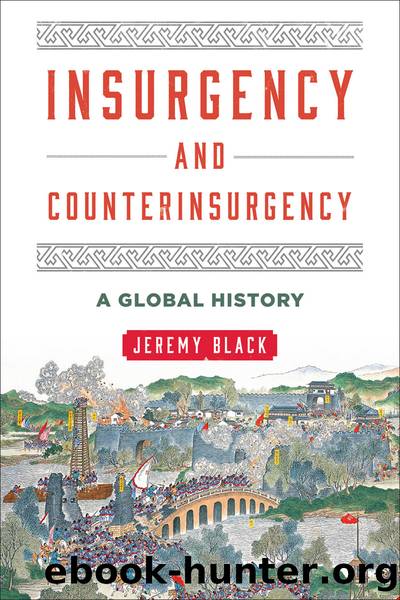Insurgency and Counterinsurgency by Jeremy Black

Author:Jeremy Black
Language: eng
Format: epub
ISBN: 9781442256330
Publisher: Rowman & Littlefield Publishers
However, whatever the truth of this, public opinion would not have stood for a tough policy, while the government, confronting the need to increase the number of troops sent to Ireland,15 was also faced by a range of difficult imperial commitments. The IRA thus benefited from such issues as the Russian Civil War and from new British commitments in the Middle East. In a wider, strategic sense, this is frequently the case for insurgencies: the need to hold on until the international situation leads their opponents to change policy.
Once the British had withdrawn from the bulk of Ireland, the IRA split, with a faction, the Irregulars, rejecting the peace settlement with Britain which had led to the partition of Ireland, with Northern Ireland remaining with Britain. This rejection led, in 1922â23, to a fresh insurgency struggle, but in this, the forces of the new Irish state successfully overcame opposition. In part, in a manner generally neglected in the Irish public myth, this success was a matter of more brutal conduct than that of the British, notably the execution of 77 insurgents and the internment or sentencing of 8,338. In addition, the âanti-treatyâ rebels lacked a psychological drive comparable to what they had experienced against the British. Later Irish governments continued to use large-scale internment against the IRA.16
More generally, the British empire confronted serious problems in a number of colonies. In part, this was an aspect of the way in which (throughout its course) empire was not a pacified or finished product, so that the imperial project and decolonization were concurrent or, at least, greatly overlapped. In a volatile political situation in 1919, British-commanded Indian troops fired on demonstrators at Amritsar in northwest India, causing heavy casualties. This episode led to a major clash between the assumptions of the commander, Brigadier General Reginald Dyer, and his supporters and, on the other hand, critics of what was seen as undue force. Dyerâs report made it clear that he regarded this force as a key constituent of control: âI fired and continued to fire till the crowd dispersed, and I considered that this is the least amount of firing which would produce the necessary moral and widespread effect it was my duty to produce if I was to justify my action.â17
Dyer, however, was recalled. His methods no longer appeared appropriate and have indeed been much criticized since.18 British leaders visiting India frequently go to Amritsar in order to express regret.
In 1920, a major revolt in the mid-Euphrates valley in Iraq was crushed by the deployment of a substantial force from Britainâs Indian army as well as of aircraft from the newly formed Royal Air Force. The exploitation of new technology, in the shape of policing from the air, was to be important in counterinsurgency operations during the century and was presented as such from the outset.19 More generally, problems were accentuated when the focus was on effective, rather than solely formal, control. The strengthening of empire could also cause a reaction. Thus, the
Download
This site does not store any files on its server. We only index and link to content provided by other sites. Please contact the content providers to delete copyright contents if any and email us, we'll remove relevant links or contents immediately.
| Africa | Americas |
| Arctic & Antarctica | Asia |
| Australia & Oceania | Europe |
| Middle East | Russia |
| United States | World |
| Ancient Civilizations | Military |
| Historical Study & Educational Resources |
The Dawn of Everything by David Graeber & David Wengrow(1647)
The Bomber Mafia by Malcolm Gladwell(1583)
Facing the Mountain by Daniel James Brown(1503)
Submerged Prehistory by Benjamin Jonathan; & Clive Bonsall & Catriona Pickard & Anders Fischer(1419)
Wandering in Strange Lands by Morgan Jerkins(1372)
Tip Top by Bill James(1350)
Driving While Brown: Sheriff Joe Arpaio Versus the Latino Resistance by Terry Greene Sterling & Jude Joffe-Block(1338)
Evil Geniuses: The Unmaking of America: A Recent History by Kurt Andersen(1315)
Red Roulette : An Insider's Story of Wealth, Power, Corruption, and Vengeance in Today's China (9781982156176) by Shum Desmond(1313)
The Way of Fire and Ice: The Living Tradition of Norse Paganism by Ryan Smith(1303)
American Kompromat by Craig Unger(1268)
It Was All a Lie by Stuart Stevens;(1263)
F*cking History by The Captain(1253)
American Dreams by Unknown(1234)
Evil Geniuses by Kurt Andersen(1223)
Treasure Islands: Tax Havens and the Men who Stole the World by Nicholas Shaxson(1218)
White House Inc. by Dan Alexander(1176)
The First Conspiracy by Brad Meltzer & Josh Mensch(1139)
The Fifteen Biggest Lies about the Economy: And Everything Else the Right Doesn't Want You to Know about Taxes, Jobs, and Corporate America by Joshua Holland(1087)
